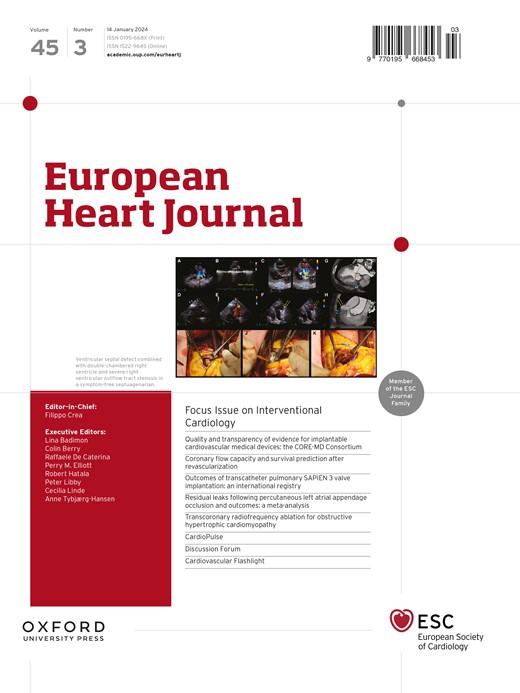Empagliflozin enhances metabolic efficiency and improves left ventricular hypertrophy in a hypertrophic cardiomyopathy mouse model.
IF 37.6
1区 医学
Q1 CARDIAC & CARDIOVASCULAR SYSTEMS
引用次数: 0
Abstract
BACKGROUND AND AIMS Hypertrophic cardiomyopathy (HCM) is a genetic cardiac disorder characterized by left ventricular hypertrophy (LVH), diastolic dysfunction, and impaired metabolic efficiency. This study investigates the therapeutic potential of the sodium-glucose cotransporter 2 inhibitor (SGLT2i) empagliflozin (EMPA) in ameliorating these pathological features in a mouse model carrying the myosin R403Q mutation. METHODS Male mice harbouring the R403Q mutation were treated with EMPA for 16 weeks. Multi-nuclear magnetic resonance spectroscopy (31P, 13C, and 23Na MRS), echocardiography, transcriptomic, proteomic, and phosphoproteomic profiling were utilized to assess metabolic, structural, and functional changes. RESULTS Empagliflozin facilitated the coupling of glycolysis with glucose oxidation and normalized elevated intracellular sodium levels. Treatment resulted in a significant reduction in LVH and myocardial fibrosis as evidenced by echocardiography and histopathology. These structural improvements correlated with enhancements in mitochondrial adenosine triphosphate (ATP) synthesis, fatty acid oxidation, and branched-chain amino acid catabolism. Furthermore, EMPA improved left ventricular diastolic function and contractile reserve, underscored by improved ATP production and reduced energy cost of contraction. Notably, these benefits were linked to down-regulation of the mammalian target of rapamycin signalling pathway and normalization of myocardial substrate metabolic fluxes. CONCLUSIONS Empagliflozin significantly mitigates structural and metabolic dysfunctions in a mouse model of HCM, underscoring its potential as a therapeutic agent for managing this condition. These findings suggest broader applicability of SGLT2i in cardiovascular diseases, including those due to myocardial-specific mutations, warranting further clinical investigation.恩格列净提高肥厚性心肌病小鼠模型的代谢效率并改善左心室肥厚。
背景和目的肥厚性心肌病(HCM)是一种以左心室肥厚(LVH)、舒张功能障碍和代谢效率受损为特征的遗传性心脏疾病。本研究探讨了钠-葡萄糖共转运蛋白2抑制剂(SGLT2i)恩帕列净(EMPA)在改善携带肌球蛋白R403Q突变的小鼠模型中的这些病理特征的治疗潜力。方法对携带R403Q突变的小鼠进行EMPA治疗16周。多核磁共振波谱(31P、13C和23Na MRS)、超声心动图、转录组学、蛋白质组学和磷蛋白质组学分析用于评估代谢、结构和功能变化。结果塞格列净促进糖酵解与葡萄糖氧化的偶联,使细胞内钠水平升高正常化。超声心动图和组织病理学证实,治疗导致LVH和心肌纤维化显著减少。这些结构的改善与线粒体三磷酸腺苷(ATP)合成、脂肪酸氧化和支链氨基酸分解代谢的增强相关。此外,EMPA可改善左心室舒张功能和收缩储备,这主要表现为ATP的增加和收缩能量消耗的降低。值得注意的是,这些益处与下调雷帕霉素信号通路的哺乳动物靶点和心肌底物代谢通量的正常化有关。结论:sempagliflozin可显著减轻HCM小鼠模型的结构和代谢功能障碍,强调其作为治疗HCM的药物的潜力。这些发现表明SGLT2i在心血管疾病(包括心肌特异性突变引起的心血管疾病)中具有更广泛的适用性,需要进一步的临床研究。
本文章由计算机程序翻译,如有差异,请以英文原文为准。
求助全文
约1分钟内获得全文
求助全文
来源期刊

European Heart Journal
医学-心血管系统
CiteScore
39.30
自引率
6.90%
发文量
3942
审稿时长
1 months
期刊介绍:
The European Heart Journal is a renowned international journal that focuses on cardiovascular medicine. It is published weekly and is the official journal of the European Society of Cardiology. This peer-reviewed journal is committed to publishing high-quality clinical and scientific material pertaining to all aspects of cardiovascular medicine. It covers a diverse range of topics including research findings, technical evaluations, and reviews. Moreover, the journal serves as a platform for the exchange of information and discussions on various aspects of cardiovascular medicine, including educational matters.
In addition to original papers on cardiovascular medicine and surgery, the European Heart Journal also presents reviews, clinical perspectives, ESC Guidelines, and editorial articles that highlight recent advancements in cardiology. Additionally, the journal actively encourages readers to share their thoughts and opinions through correspondence.
 求助内容:
求助内容: 应助结果提醒方式:
应助结果提醒方式:


